
history, memory, and mystery; the fabulous and the raw.
Ferenike, The Book of Perilous Dishes, The Phanariot Manuscript.
Author of 15 novels and over 300 stories
Hot News: Doina Ruști
Short
Doina Ruști is one of Romania’s leading contemporary novelists. She is the author of fourteen novels and three short story collections, widely acclaimed for their blend of historical fiction, fantastical elements, and political depth. Her work is studied in schools and has received major national awards, including the Romanian Academy Prize and the Writers’ Union Prose Award.
Her Phanariot Trilogy — The Phanariot Manuscript, The Book of Perilous Dishes", and Homeric — explores 18th-century Balkan history through magical-realist lenses. [The Book of Perilous Dishes] was published in English by Neem Tree Press (UK, 2022 & 2024). Other notable titles include Lizoanca at the Age of Eleven (translated into 7 languages) and The Ghost in the Mill, a sweeping narrative about Romanian communism.
Her most recent books — Occult Beds), Zavaidoc in the year of love, and Ferenike — are bestsellers in Romania.
Ferenike, her most personal and politically resonant novel, is an autobiographical fiction that spans six decades of Romanian history, guilt, and feminine resistance.
In parallel, she is a university professor and screenwriter, teaching cultural history and creative writing at the University of Bucharest.
Doina Ruști / Doina Rusti
Website: www.doinarusti.ro
Select platforms: Instagram \| YouTube
https://www.facebook.com/rustido
https://adevarul.ro/blogs/doina.rusti
Literary networks and thematic resonances: Mircea Cărtărescu, Gabriela Adameșteanu, Herta Müller, Olga Tokarczuk, Mariana Enriquez. More
Featured guest on ALTCEVA cu Adrian Artene – Romania’s most-watched cultural podcast (2025)
The Phanariot Manuscript în Sardinia

Large
DOINA RUȘTI’s (February 15th, 1957) ancestors are from Montenegro, they are Turks, Jews and especially Danubian Romanians, and her writings are outlined by a highlighted Balkanism and a mythical realm of various sources. She spent her childhood in a village in southern Romania (Comoșteni), raised by a family of teachers, who made great efforts to survive in a communist world. The absurd rules and chaos reigning at the end of the dictatorship are stressed in The Ghost in the Mill, a novel that depicts a fantastic universe, ruled by ghosts and hierophanies. The novel earned her the Writers' Union of Romania’s Award, and it was deemed "one of the most convincing and expressive works of fiction about domestic communism published in the last decade". (Paul Cernat).
Translated into German, it was acclaimed in the newspaper Neue Zürcher Zeitung: "Doina Ruști's book displays a wide range of literary skills, which will surely prevail in the Romanian history of the twentieth century."
In J. A. Weinstock's Encyclopedia, the style of the novel The Ghost in the Mill is classified as neo-Gothic.
Other novels are written in the same fantasy vein. Zogru (translated into Italian, Hungarian, Spanish, Bulgarian) brings forward an unusual character and a fantasy style akin to the one portrayed in Chagall's paintings, as noted in a daily newspaper from Santiago de Chile:
“Full of humor in some scenes, tragic and fierce in others, marvelous and bright at times, like a Chagall painting, this wonderful story is governed by the terrible loneliness that encapsulates the human spirit in the absence of love.” (Pedro Gandolfo, El Mercurio)
The novel received the Writers' Union Award, alongside a scholarship from the Hungarian government and enthusiastic reviews, including in Italy.
The same style is used in novels such as The Little Red Man (2004), Homeric (2019) and Occult Beds (2021), but especially in The Book of Perilous Dishes. The latter, probably her most translated novel, was awarded the Prize for the best translated book by the Hungarian Writers’ Union (Budapest, 2017), and it was acclaimed for its fantastic narrative and style:
The Book of Perilous Dishes – a stylistic delight, essential literature, similar to Süskind’s Perfume up to a point and then to Evgheni Vodolazkin’s Laurus from that point forward. (Dan C. Mihailescu).
The Phanariot Manuscript (2015), partially translated into English, distinguishes itself by bringing into play a type of magical, fabulous and lyrical realism.
Academic study by Doina Ruști published in the Journal of Linguistics, University of Craiova.
Other novels draw on raw realism. Among them, Lizoanca at the age of eleven, which has been highly praised by both the national and foreign press, was granted the Ion Creangă Award by the Romanian Academy in 2009. The novel was often admired for both its literary value (La Opinion – Murcia, La Jornada, Mexico) and authentic writing:
“Doina Ruști gradually unfolds the story and prolongs pain and terror until they reach unsuspected heights, by bringing their roots to the surface. She succeeded in writing about that dark and even invisible part of society, questioning many of its crucial aspects. Doina Ruști has the rare ability to depict the hypocrisy of man and society at large, the many displays of cruelty disguised as most harmless acts which, at the same time and under the guise of apathy in epic development, wield their ceaseless corrosive power. A pictorial and cinematic writing, achieved in part thanks to the perfect use of comparison.” (Ramón Acín, Turia, 2015).
A Budapest daily newspaper ranks it among the best books translated in 2015, along with Houellebecq's Submission, and Il Libero (Turin) compares it in style to Camus' The Plague.
The Little Red Man was very well received in our country and in Italy, acclaimed for its originality of delivery (La Stampa), complexity of theme (Il Venerdì di Repubblica) and fantasy distinctness (Stato).
„…un mondo allucinato, convulso, assurdo eppure coerente e reale quanto sa esserlo la fantasia, un bizzarro e imprevedibile Paese delle Meraviglie elettronico in cui Laura si avventura incantata e indomita come un’Alice telematica.” (Roberto Merlo –“Ritorno a Babele", Neos Edizioni, 2016, Torino)
Taking an interest in both the fantastic and the realistic realms, Doina Ruști succeeds in writing about the atrocities of the contemporary world just as convincingly as she does about high ideals. Her characters, whether realistic or fantastic, are memorable and outstanding.
A relevant example is the character Dragobete, the god of love, reinterpreted in a recent short story.
Her novels are often populated by rapists, murderers, starving people, corrupt and consumed by petty ideals. But with the same skill wielded by the well-versed novelist, Doina Ruști also builds fantastic characters, elves, goblins, ghosts, enchanted tomcats and sorcerers, a craft that prompted some critics to compare her work to that of Bulgakov, Süskind or Marquez. (apud Dan C. Mihailescu, Bojidar Kuncev).
The wide variety of themes, steadfastly moored to present times, as well as Doina Ruști’s distinctive ability to easily switch her narrative style earned her an unquestionable place among the best writers of contemporary Romanian literature. (Nicolae Breban).

Doina Ruști, Nicolae Breban
Doina Ruști lives in Bucharest, is a professor: The History of Universal Culture & Civilization. Currently only creative writing workshops at the University of Bucharest.
Convinced that giving up on the names of her ancestors is one of the great challenges man undertakes, she writes under Ruști.

This is the first exegesis of Eliade's work since the fall of communism, in which both his fiction and his scientific work are analyzed. It contains almost 100 symbols, arranged in two large categories: fundamental opposites and coincidentia oppositorum (harmony of opposites).
This is Doina Ruști's debut book. More
Her writings have been honored by exegeses and laudatory reviews in numerous daily newspapers and international literary magazines, including El Mercurio (Santiago de Chille), Neue Zürcher Zeitung, Il Manifesto, Las Últimas Noticias, La Jornada (Mexico City), Stato Quotidiano, Turia, La Stampa, La Opinión, Il Libero, Magyar Nemzet, La Repubblica, Beijing Daily and others.
Web page: http://doinarusti.ro
Trans Bianca Zbarcea
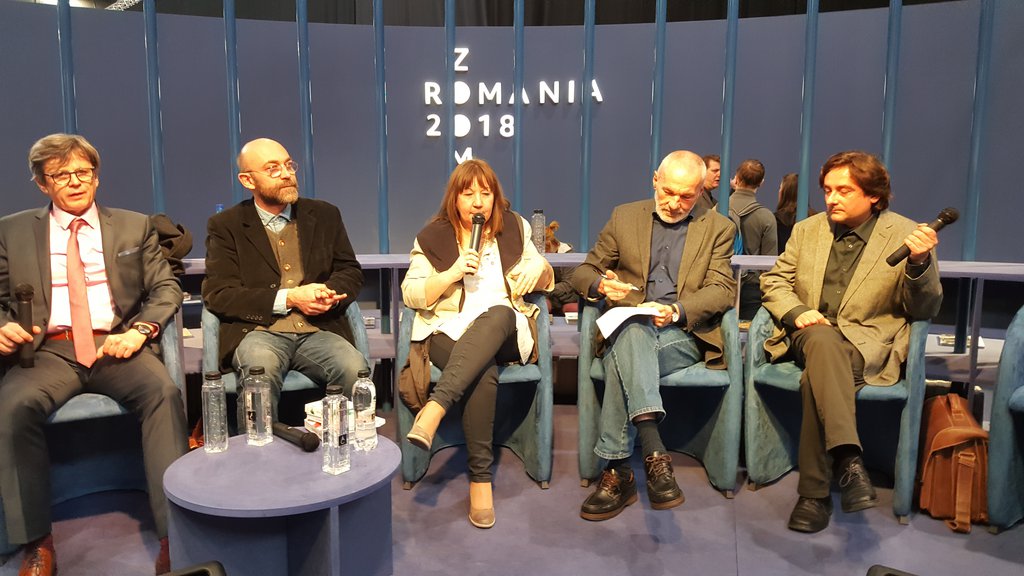
Leipzig, 2018: Doina Ruști & Filip Florian
[Leipzig: Doina Ruști & Lizoanca]
Doina Ruști is an active member of the Writers’ Union of Romania, PEN Club Romania, and the Writers & Fiction Makers Association (ACF).
She is also affiliated with Dacin-Sara (copyright management for film and screenwriters) and Copyro (literary rights).
Her editorial collaborations include leading Romanian publishers — Humanitas, ART, Polirom, Litera, Vremea, and Bookzone — as well as international partners through New Europe Writers and the EU–China Literary Festival,Historical Novel Society(USA)
She has also been a guest author at the L’Isola delle Storie – Gavoi Literary Festival (Sardinia, Italy), where she was introduced by Italian novelist Marcello Fois, founder and president of the festival.
She is a regular contributor to Ficțiunea magazine, a major Romanian literary platform.
Her work has been featured at Frankfurt Book Fair, Worlds Without End, Amazon Books, and other international showcases.
For recent media coverage, interviews, and international features, see the News & Press
For critical essays, book reviews, and scholarly studies on her work, visit Critical Reception
“Read, men, what women have written about you!” — motto of her literary philosophy.

I was kind of an explorer. I was expecting to discover amazing things, different from what my family discovered in the books they had read. My father loved poetry. My grandmother was reading contemporary novels, often Romanian ones. My mother was fond of the emotional romance books. And my grandfather’s reading taste was extremely diverse. Besides, he was the only one in the family who was reading even the newspaper. In this context, I secretly started to read Balzac at the age of 14. And not just one, but his entire volumes from our library shelf. The broad phrase and the solid structure of his novels gave me such comfort that I was convinced that I would not read any other writer for the rest of my life. Balzac was my first love or, in other words, that perfume that evaporates whenever one wants to retrieve it.
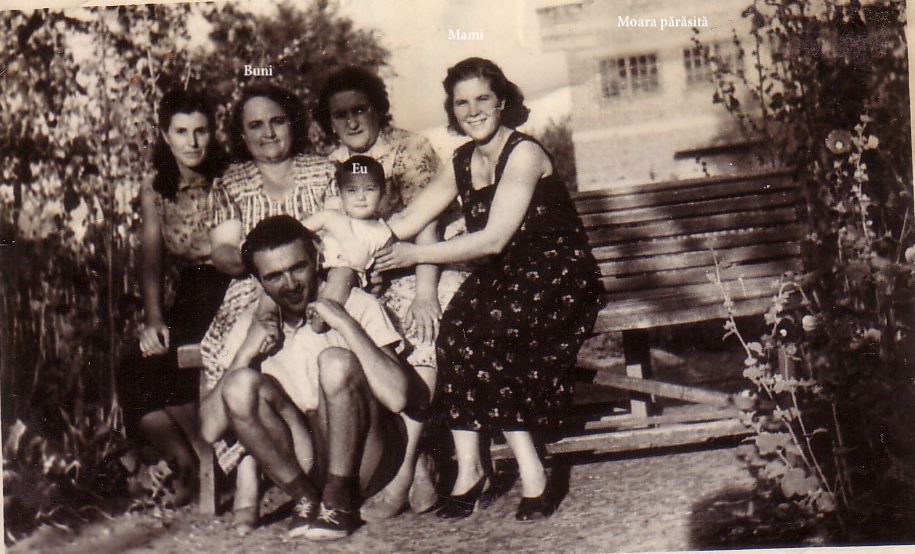
Doina Duști & her Family
Beijing (2019), Madrid (2019), Goangzhou, Shenzhen (2018), Gavoi (2018), Santiago de Chile (2018), Istanbul (2015), Barcelona (2014), Budapesta (2007, 2014, 2015, 2018), Viena (2008), Plovdiv (2009), Torino (2009, 2011, 2012, 2013), Frankfurt (2009, 2018), Leipzig (2010, 2013, 2018), Moscova (2010), Roma (2011, 2012), Granada (2011), Dusseldorff (2013), Berlin (2013).
Contemporary Writers, with
2007-2008 Training internship: Story editing, Script editing. Centre for Research on the Wider Benefits of Learning (WBL) & Centre for Adult Literacy and Numeracy (NRDC). Coord. John Vorhaus.
2000 Ph.D, University from Bucharest
1976-1980 Faculty of Philology, "Al. I. Cuza" University, Iași
1972-1976 Garabet Ibraileanu Highschool (Classical Languages), Iași
When I graduated, I was 23 years old and i looked like a starved Asian. I was coming to Bucharest every month, carrying different manuscripts with me and trying to enter a publishing house. Usually there was someone, a janitor, and I could never get past him. Even now I have many files with short prose, that were very fashionable at the time. "The Ghost in the mill" itself dates back to the same period.

Doina Ruști, 1978, student
Bucharest University
Member of The Writers' Union of Romania
Member of PEN Club
Dacin Sara
Doina Ruști — Selected Works
Ferenike (2025, Humanitas) — 74,000 w; bestseller
An autobiographical novel based on a murder witnessed in a 1968 Danube village, weaving Balkan cultural textures with Cold War intrigue and historical-political ties involving Nixon, Ceaușescu, and Romania.
The Wild Girl (Sălbatica,), Booklet, 2025) — 65,000 w
A YA novel set during the Stalinist deportations, telling an optimistic love story between two teenagers. It explores resilience and hope amidst a dark chapter of history. The entire text is translated into English.
Platanos, Youngart, Grupul Editorial Art, 2025 - 70.000. An unhappy boy, a Christmas wish, and… a metamorphosis. Platanos is a dystopia, continuing the short story of the same title, studied in middle school, written at the request of students and teachers.
Zavaidoc in the Year of Love (Zavaidoc în anul iubirii) (2024, Bookzone) — 80,000 w
The love story of a famous interwar singer, set in 1923 and told from three different perspectives. A national bestseller and nominee for Bookzone’s Best Fiction Book.
Occult Beds (Paturi oculte) (2020, 2022, Litera) — 75,000 words
A sensual, esoteric novel set in Bucharest, blending urban realism with mysticism, erotic tension, and a spectral atmosphere. Fantasy and speculative fiction with strong appeal to YA readers.
Adapted into mini-films by 54 high schools.
Homeric (2019, Polirom)
The story of a magical plant, pressed between the pages of the Iliad—a fantasy-tinged mystery and love story, narrated by an enigmatic character whose identity is revealed only toward the end. The third novel in the Phanariot Trilogy.
The Book of Perilous Dishes (Mâța Vinerii) (2017, Polirom) — 80,000 words
The second volume of the Phanariot trilogy, blending magic, history, and culinary arts. Featuring sorcerers and enchanted recipes, the novel explores mystical and political intrigues of the 18th-century Balkans.
Internationally praised and translated into English, Spanish, German, Hungarian, and Chinese. Premiered in Budapest.
The Fiancée (Logodnica) (2017, Polirom)
A Norwegian man paid me to write the story of his great love for a Romanian woman. I agreed—on one condition: I would also tell her side of the story. What emerged is a sharp, ironic bestseller about love, illusion, and the unbridgeable gulf between Eastern and Western Europe.
The Phanariot Manuscript (Manuscrisul fanariot) (2015, Polirom; 2022, Litera)
The first novel of the Phanariot Trilogy — an atmospheric love story set in 18th-century Bucharest, based on a real historical manuscript: an actual contract for the sale of a human being. Richly researched and layered, the novel explores themes of power, desire, and destiny in the Ottoman-influenced Balkans. It has gone through multiple Romanian editions and has been translated into Albanian, with excerpts published in English, Turkish, and Italian. A full Spanish translation is currently underway.
Lizoanca at the Age of Eleven (Lizoanca la 11 ani) (2009, Trei; reissued by Polirom 2017, Litera, in the author’s series, 2023)
A powerful and controversial coming-of-age story set in rural Romania, based on a true case of an 11-year-old girl accused of causing illness in an entire village. Awarded the Romanian Academy’s Ion Creangă Prize. Translated into German, Spanish, Hungarian, Serbian, Macedonian, and Italian.
The Story of an Adulterer (Mămica la două albăstrele) (2013, Polirom; Litera 2024, author’s series)
A psychological, realist novel exploring the hypocrisy surrounding child adoption and the exhaustion of the family institution, all set against the backdrop of an adulterous affair. Featuring elements of crime and deep psychological insight.
Four Men Plus Aurelius (Patru bărbați plus Aurelius) (2011, Polirom) — 50,000 w
A bizarre short novel, told with a comic-strip sensibility, about a woman who seemingly accidentally kills four men, while grappling with a psychosis centered on the belief that she killed Aurelius—the beloved kitten of her grandfather.
The Ghost in the Mill (Fantoma din moară) (2008, 2017, Polirom; 2024, Litera, author series) — 110,000 words
My most important novel and greatest success to date. Upon publication, several literary magazines dedicated entire issues to it. A complex and stylistically innovative novel about Romanian communism, built around a rewritten biography told in the rhythm of a thriller, with a gothic atmosphere. It explores the idea that no crime can be judged by laws other than those that created it.
Winner of the Union of Romanian Writers’ Prose Award. Translated into German.
Zogru (2006, 2013, Polirom; Litera 2022)
The story of an immortal being who lives through history from Dracula’s era to the present—a picaro who dwells in human blood and alters destinies. Also a witty and humorous dismantling of the vampire myth, exploring human solitude with irony. Winner of the Writers’ Union Prose Award. Translated into Italian, French, Spanish, Hungarian, and Bulgarian.
The Little Red Man (Omulețul roșu) (2004, Vremea; 2020, Litera) — 100,000 w
A fable-like fantasy and metafictional manifesto about storytelling and transformation. Set during the early years of the internet, it follows a woman’s rebellion and the uncanny appearance of a little red man—born from the frustrations of a society just emerging from communism.
My literary debut and personal manifesto, the novel explores themes of isolation, feminine revolt, and the mutability of narrative itself.
Awarded by Convorbiri Literare magazine. Translated into Italian (two editions).
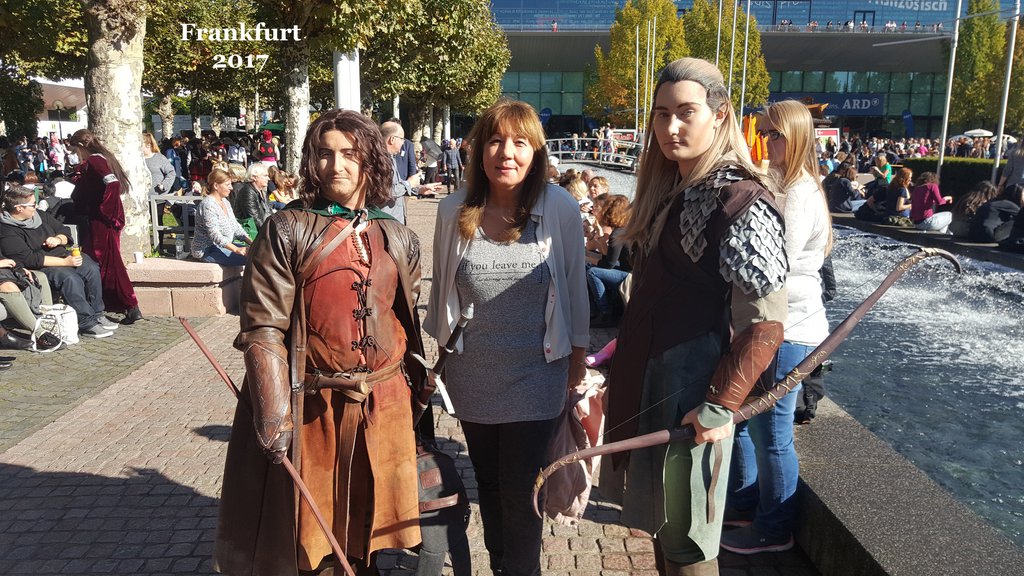
[Frankfurter Buchmesse, 2017: Doina Ruști]
STORIES
The Plaid Shirt and 10 Other Tales from Bucharest (Cămașa în carouri și alte 10 întâmplări din București)(2010, Polirom; 2023, Litera) — 45,000 w
A collection of eleven fantastical urban stories featuring time travel, miracles, love, and death—where Bucharest itself becomes a living character. The tales are subtly interconnected, culminating in a unified finale. Written in a style reminiscent of Mariana Enriquez. Several stories from this volume have been translated individually into various languages.
Amorous Oddities from Phanariot Bucharest (Ciudățenii amoroase din Bucureștiul fanariot) (2022, Litera) — Bestseller
Around 50 short stories based on historical records and private manuscripts (lists of found, stolen, or purchased objects, etc.).
The Debauched Man of Gorgani (Depravatul din Gorgani) (2023, Litera) — Bestseller
A thematic short story collection set in the 18th-century Phanariot era, exploring various acts of debauchery.
NB: I have also written nonfiction, including The Dictionary of Symbols in Mircea Eliade’s Work.

Dorëshkrimi fanariot (Manuscrisul fanariot), trad. Maniela Sota (2024, albaneză, Prishtinë).
A malom kísértete (Fantoma din moară), trans. Szenkovics Enikő. (2024, Budapesta),
Zogru, Les Editions du Typhon; Marseille, 2022. Trad. Florica Courriol
The Book of Perilous Dishes(Mâța%20Vinerii%3C) https://neemtreepress.com/book/the-book-of-perilous-dishes/>, Neem Tree Press, London, 2022, 2024 (trans James Ch. Brown).
L’omino rosso, Sandro Teti, Roma, 2021 (trad Roberto Merlo)
Cong Quanshan Dao Pingyuan, trans Siqi Zhu, De Li Zan, Beijing, 2019
La gata del viernes (Mâța Vinerii), trans Enrique Nogueras, Editura Esdrújula Ediciones, Granada, 2019
Freitagskatze (trad Roland Erb), Klak, Berlin, 2018
Zogru trad. Sebastián Teillier, Descontextos Editore, Santiago de Chile, 2018
Das Phantom in der Mühle , trad. Eva Wemme, Klak Verlag, 2017, Berlin
The Truancy, The Stockholm Review Literature
The Phanariot Manuscript (trans Liana Grama &Andrew Davidson), Trafika Europe, Penn State, University Libraries, nr 8, 2016
The lover (trans Andrew Davidson), Trafika Europe, Penn State, University Libraries, nr 8, 2016
Eliza (Lizoanca) trans. Alexandra Kaitozis, Antolog, 2015, Skopje
Eliza a los once años, Ediciones Traspiés, Granada, 2014 (trans Enrique Nogueras)
Lizoanca tizenegy évesen trans. Szenkovics Enikő Orpheusz Kiadó, Budapest, 2015
Fenerlilere ait elyasmasi eser (Manuscrisul fanariot), frag, trans. Leila Unal, Sözcükler , 58, aprilie, 2015, Istanbul
Zogru, Sétatér Kulturális Egyesület, 2014, prin bursa "Franyó Zoltán", oferită de guvernul maghiar (trans Szenkovics Enikő)
Lizoanca, Horlemann Verlag, Berlin, 2013 (trad Jan Cornelius)

[Berlin: Jan Cornelius, Doina Ruști, Georg Aescht, Gabriela Adameșteanu]
Lisoanca, Rediviva Edizioni, Milano, 2013 (trad Ingrid Beatrice Coman)
Apartamentul 26, trans. Oana Ursulesku, Koracic, Belgrad, 2013
L’omino rosso, Nikita Editore, Firenze, 2012 (trad Roberto Merlo)
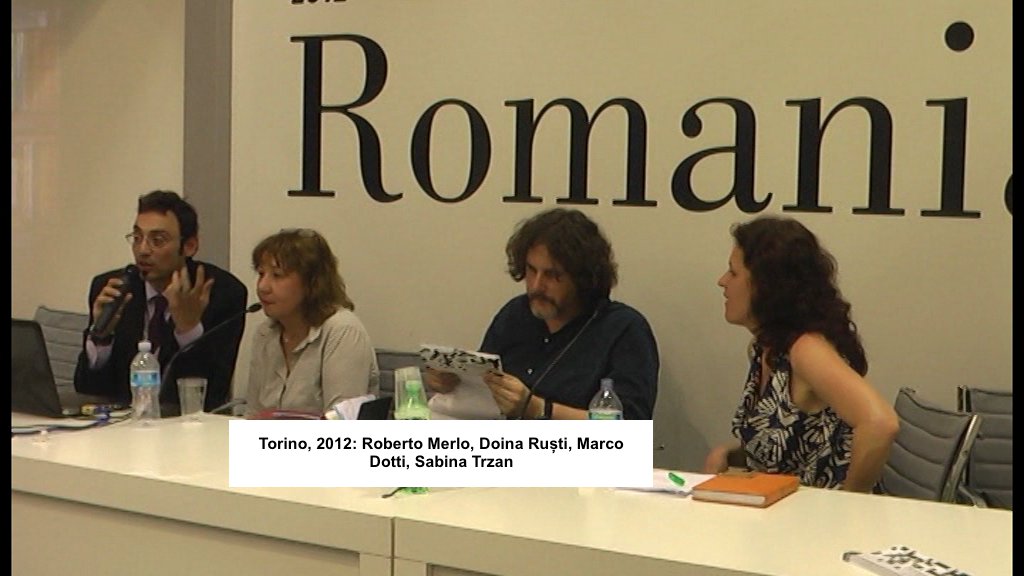
Robero Merlo, Doina Ruști, Marco Dotti, Sabian Trzan
Bill Clinton’s Hand, Bucharest Tales, New Europe Writers, 2011, (coord:A. Fincham, J. G Coon, John a’Beckett)
Kareli gomlek ve Bukreș'teki Bașka On Hadise (Cămașa în carouri și alte 10 întâmplări din București), trans. Cristina Dincer, Kalem Kultur Yaynlari, Istanbul, 2011
I miei ginecologi, in Compagne di viaggio, Sandro Teti Editore, 2011 (trad Anita Bernacchia) (coord Radu Pavel Gheo, Dan Lungu)
Ura pri univerzi, Zgodbe iz Romunije, Sodobnost International, Ljubljiana, 2011.
Zogru (trad. Roberto Merlo), Ed Bonanno, 2010, Roma; Catania
L’omino rosso (trad Roberto Merlo) în Il romanzo romeno contemporaneo, Ed. Bagatto Libri, 2010, Roma.
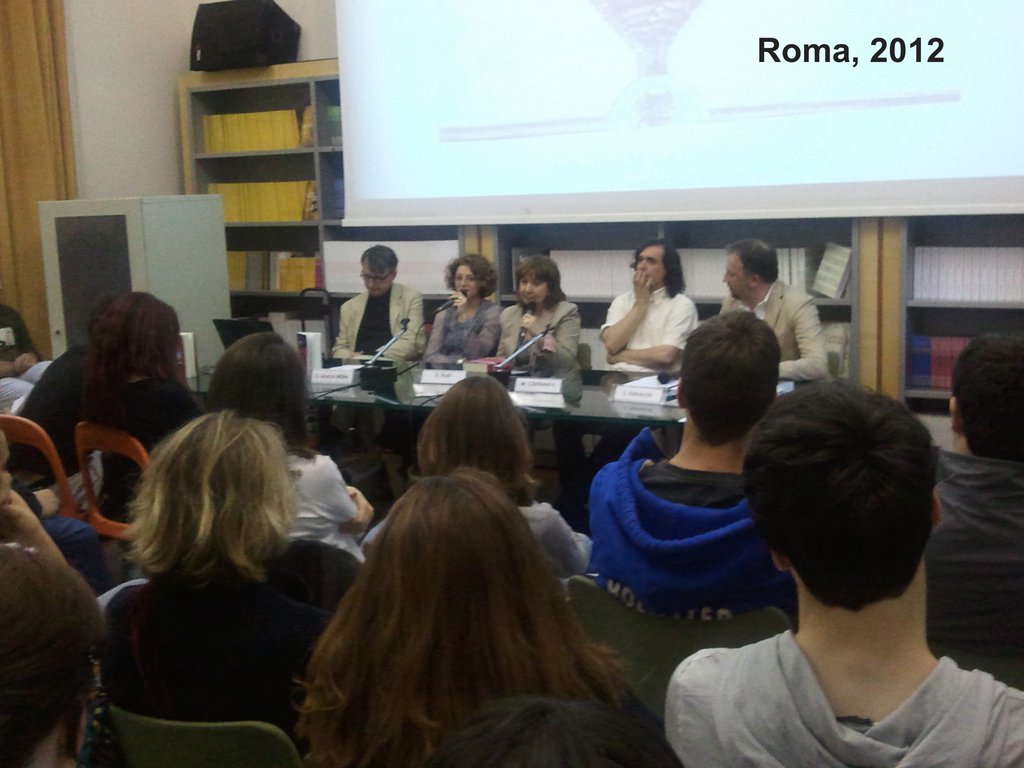
[Roma: Stefano Petrocchi, Mircea Cărtărescu, Doina Ruști, Oana Bocșa Mălin, Horia-Roman Patapievici]
Zogru (frag.) și prezentare biobibliografică, în 11 books contemporary romanian prose, Ed. Polirom, 2006, traducere de Alistair Ian Blyth
Zogru (roman), Balkani Publishing House, Sofia, trad: Vasilka Alexova, 2008.
Învingătorul - antologia revistei Nagyvilag (trad. Noémi László), Budapesta , sept/ 2010
Cristian (trad. în fr. Linda Maria Baros), Paris, rev Le Bateau Fantôme , no. 8, 2009, ed. Mathieu Hilfiger
Cristián (trad. Sebastián Teillier), Madrid, rev. El fantasma de la glorieta, nr. 16/2008,
The begining (poem), in Under a Quicksilver Moon, 2002, SUA, Library of Congress,
Dicționar de simboluri din opera lui Mircea Eliade(frag.) în La Jornada Semanal, nr. 455; 456, 2003 (traducere: José Antonio Hernández García)
Director
The Soldier’s Book, documentary, 2018
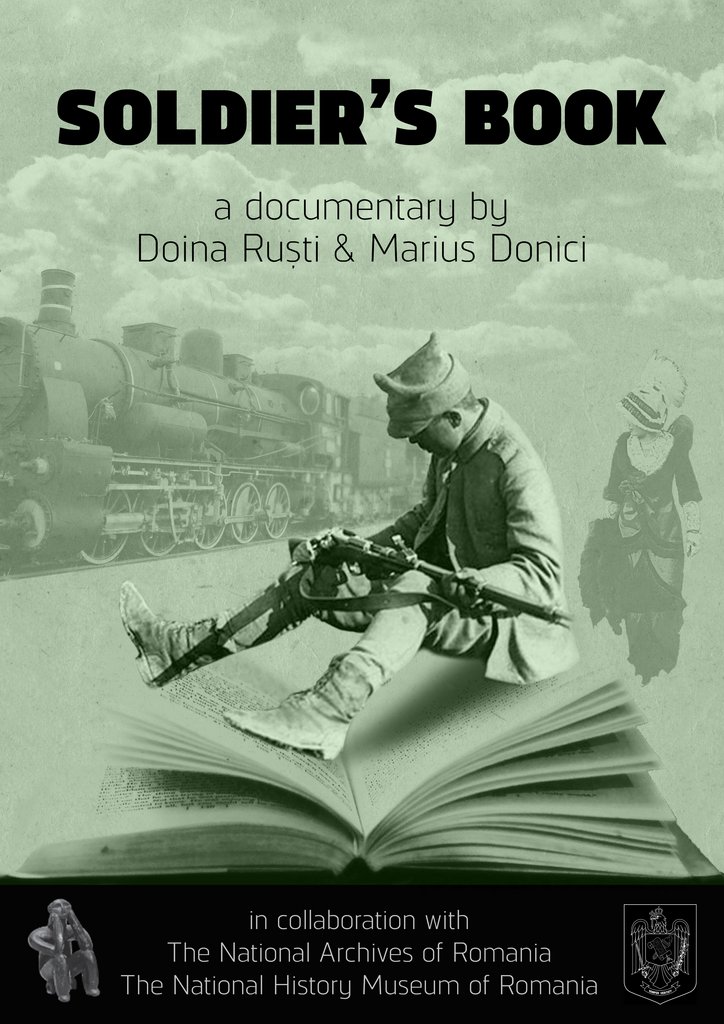
Umbra perfidă a unei iubiri (The insidious shadow of love), SM, fiction
Ascona Film Festival, 2017
Festival Dona i Cinema – Mujer y Cine – Woman & Film, Spania, 2017
Cinefest, Los Angeles, 2017
GOLDEN BRIDGE INTERNATIONAL FILM FESTIVAL, Moscova, 2017

185 de ani de existență a ANR (Homage to the National Archives of Romania), Documentary
Cristian (written&directed by Doina Rusti), SM, fiction, 2015. Selected at Goa Festival; CineFest, Los Angeles; Corner Cannes; Independent Film Festival and Windsor Festival; Christian Film (Award for Best Foreign Film); Les Films de Cannes à Bucarest, 2015,

Cristian by Doina Ruști, Mediafax
National Archives (written&directed by Doina Ruști), documentary.
Romanian Litterature (written&directed by Doina Ruști), documentary.
Writer
Nuns witch (directed by Marius Barna), L documentary, docudrama, CNC project financing. in post-production
Sun Dance (directed by Cornel Gheorghita), documentary, L, financed by CNC, 2015
Treasure naive (d. Copel Moscu), documentary, financed by the CNC 2015 post-prod.
Servant Greek (d: Germain Kanda), documentary, docu-drama, Elephant Film, co romanao-Swiss project ORW, 2015
Cream truffles, LM, fiction, Libra Film (Tudor Giurgiu) project funded CNC. Developing.
35 minutes after (directed Cristi Toporan), fiction, Short.
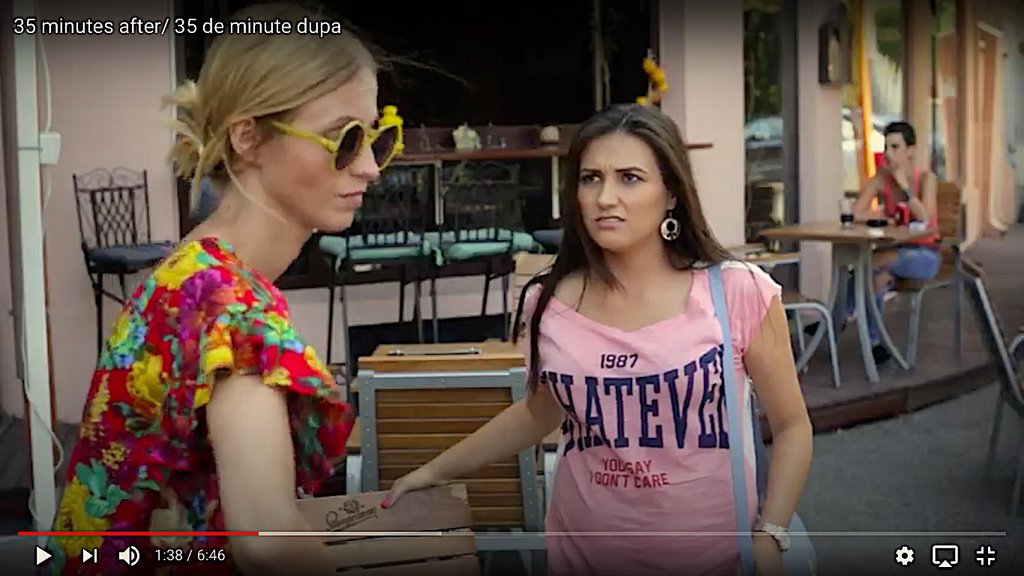
Fraud, directed by Cristian Panaitescu independently , fiction, short. 2014.
Apartment 26, indep. (Directed by Alexandra Băilă), fiction, short.
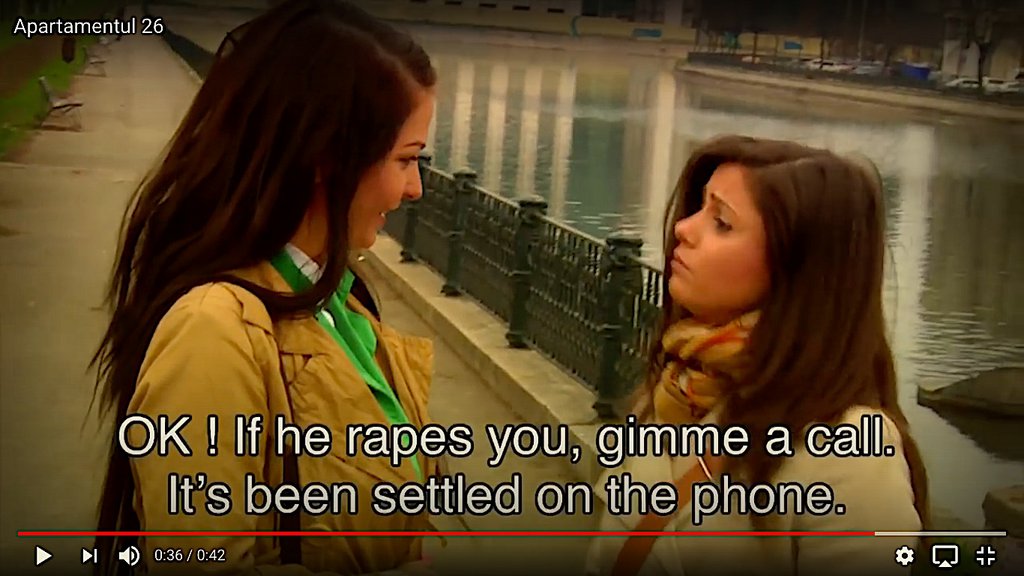
Dialogues and adaptation
Miracle at Tekir Elephant Film, Zurich
LM, fiction, 2015 (completed) Award best picture Swiss, Zurich, 2015:
Ateneu (literary magazine) Prize for Prose, 2015
The Romanian Academy Ion CREANGĂ Prize, 2011
The Romanian Writers' Union Prize for Best Prose/2008
The Prize of the Bucharest Writers’ Association/2007 Convorbiri literare (literary magazine) Prize for Prose, 2006
Nomination for The Book of the Year Award 2008, 2016
Diploma for supporting National Archives (ANR), 2016
The Golden Medal of "Schitul Darvari", for Literary Activity, 2008
Excellence in Teaching - National Award (2000)
"Full of humor in some sequences, in other tragic and ferocious, sometimes fantastic and luminous, like a Chagall painting, which is predominant in this wonderful story Zogru is the figure of the terrible loneliness in which lies the human spirit " (Pedro Gandolfo, El Mercurio, August 19, 2018)
"The Phantom is the narrative catalyst that makes secret forces manifest, especially those of a sexual nature, being also the most visible, single faith, dissolved in the last part of the novel." (Markus Bauer, Neue Zürcher Zeitung )
"In my opinion, the confidence, the artistry of portrayal, the exact and original description of the environment, the quest for a subtle epic crescendo, the illusion of stagnation make Doina Ruști a first class prose writer in current literature." ( Nicolae Breban, when granting the Award of Romanian Academy, 2011)
"Extraordinarias cualidades litterarias." (Antonio J. Hbero, La Opinion, 3 01 2015)
"An ironic and seductive story." (Giuseppe Ortolano - The Friday of the Republic , March 23, 2012, nr 1253)
"Amazing is the fire of a row of stunts of pungent and fulminating expressions that the author devises to describe situations and moods of her protagonist." (Alessandra Iadicicco. La Stampa , no 1815, May 12, 2012)
"Stupefacente è il fuocco di fila di trovate di espressioni pungenti e fulminanti que l'autrice escogita per descrivere situazioni e stati d'animo della sua protagonista." (Alessandra Iadicicco. La Stampa, nr 1815, 12 mai, 2012)
"The talented Romanian writer Doina Rusti, who published Lisoanca, the story of an eleven-year-old who infects an entire village with syphilis and makes victims even among her peers, is making a fool of herself, saving herself as an imaginary creature from another world . The book is also inspired by the great "health" novels, such as The Plague of Camus, where crime takes root more easily in a context of widespread disease. These are certainly the models. " (Gianluca Veneziani, Libero , May 18, 2013)
"Fa il verso ai noir fantastici la brava scrittrice rumena Doina Rusti, che ha dato alle stampe Lisoanca , storia di un’undicenne checontagia con la sua sifilide un intero villaggio, mietendo vittime anchetra le coetanee, salvopoirivelarsi una creatura immaginaria venuta da un altro mondo. Il libro si ispira anche ai grandi romanzi «sanitari», come La peste di Camus, dove il crimine attecchisce più facilmente in un contesto di malattia diffusa. questi sono certamente i modelli." (Gianluca Veneziani, Libero, 18 05, 2013)
"With her shocking book about violence against children, Doina Ruști is making a name for herself with us too. The book gets under your skin and is heavy fare. The sophisticated style contrasts with the brutal plot." (Martina Freier, ekz)
"Even the smallest detail of the novel is veridical" (Magyar Nemzet, December 31, 2015)
"A very admirable story, by the way, very well told. Highly recommended." (Miguel Baquero, The storm in a glass , December 16, 2014)
Mâța Vinerii - a stylistic jubilation, a vital literature, such as Suskind's Perfume to a point, and Evgheni Vodolazkin's Laur, from another point on. (Dan C. Mihăilescu)
The Ghost in the Mill is an imaginative novel, in line with autobiographical fiction, in which magic realism and daily realism intertwine. [...] This mill, which is an axis mundi, the center, the hearth and the obsession of the village, where the character has no clue if he has met the angel or the devil, this mill is the place where a murder occurs, as at the dawn of all worlds: a certain Max, an epileptic, is killed by mistake [...] and everybody is obliged to keep silent, thus becoming accomplices in the murder. We have all been accomplices in what has defined and punished us. This is the parable of communism. A novel with substance, a sinewy prose which, I repeat, equals a part or several parts of Mircea Cărtărescu’s Orbitor”. Dan C. Mihailescu, The man who brings the book, ProTV
"Mit ihrem erschütternden Buch über Gewalt an Kindern macht sie sich auch bei uns einen Namen. Das Buch geht unter die Haut und ist eine schwere Kost. Der anspruchsvolle Stil steht im Gegensatz zu der brutaen Handlung." (Martina Freier, ekz)
"even the smallest detail of the novel is veridical" (Magyar Nemzet, 31 decembrie 2015
"Una historia muy admirable, por cierto, muy bien narrada. Muy recomendable." (Miguel Baquero, La tormenta en un vaso, 16 12. 2014)
For recent media coverage, interviews, and international features, see the News & Press
For critical essays, book reviews, and scholarly studies on her work, visit Critical Reception
Ruști, Doina. Bibliografie critică și studii despre opera Doinei Ruști. www.doinarusti.ro/despre.html#_biblio
, accesat în 2025.
“If you need to clear the air with these gentlemen, better remove yourself from the car!” Julia’s boyfriend, or whatever he was, didn’t seem like much. I had fought more fearsome men in my life.
When I heard him mentioning my mother, whom he had started bespattering in something resembling the English language, calling her “a Norwegian whore”, I opened the door and headbutted him without the slightest hesitation. I yelled at the top of my lungs too, so that bitch, Julia, could hear me loud and clear: “I’m an Irish man, you fucking asshole, I’m from Belfast, we would stick some Semtex up your ass" trailer
If there is no reward, there is no play. People need reward to come into play.
The love is happiness to be only a rotting cloth in the wound of a stranger.
Lizoanca at the age of eleven (Lizoanca la 11 ani)
The Ghost in the Mill (Fantoma din moară)
Zogru
The Phanariot Manuscript (Manuscrisul fanariot)
The Phanariot Manuscript (Manuscrisul fanariot)
The Ghost in the Mill (Fantoma din moară)
The Little Red Man (Omulețul roșu)
The Little Red Man (Omulețul roșu)
Authored by Pompilia Chifu
A selection of studies, articles, and academic papers dedicated to the works of Doina Ruști, published in literary journals, collective volumes, and international databases.
Dan C. Mihăilescu - Femeie cu omuleț, în vol. Literatura română în postceaușism, II. Prezentul ca dezumanizare, Ed. Polirom, 2006, p. 248
Geo Vasile - Elixirul narațiunii, în vol. Romanul sau viața. prozatori europeni, Ed. Muzeul Literaturii Române, 2007, p. 343 și urm.
Dumitru Augustin Doman - Avatarurile unui duh, în vol. Cititorul de roman, Ed. Pământul, 2010, p. 122.
Emanuela Illie - Fantastic și alteritate, Junimea, 2013, p. 92 și urm.
George Marcu - Personalități feminine contemporane din România, Ed. Meronia, 2013 (dictionar)
Daniel Cristea-Enache - Un vampir de treabă și Un tovarăș de sus în vol. Timpuri noi, Ed. Cartea Românească, 2009, pp 172; 174
Dan C. Mihăilescu - Literatura româneasca în postceausism. II. Proza. Prezentul ca dezumanizare, cap. Realismul apocaliptic și deriziunea, Ed. Polirom, 2006, p. 251
Roberto Merlo - Zogru di Doina Ruști, tra storia e mito, in vol. Quaderni di Studi Italieni e Romeni, 5, 2010, Edizioni dell’Orso, pp. 121-136
Gelu Ionescu - Târziu de departe, Ed Cartea românească, 2012, pp. 112 si urm
Tania Radu - Jocuri riscante, în vol. Chenzine literare, Humanitas, 2014
Andrei Simuț - Romanul românesc postcomunist între trauma totalitară și criza prezentului. Tipologii, periodizări, contextualizări, cap. III.3. Panoramări ficționalizante ale trecutului comunist: Un singur cer deasupra lor, Fantoma din moară, Pupa russa], Editura Muzeul Literaturii Române, 2015
Călin Teutișan - cap Fantasticul levantin, în Enciclopedia imaginariilor din România. Vol. I: Imaginar literar, coord. Corin Braga, Polirom, 2020.
Adina Mocanu - La Vulnerabilidad de las niñas en la transición postcomunista: Doina Ruști y Nora Iuga, în vol. La infancia en femenino las niñas, Icaria Editorial, Barcelona, 2016, p. 2017.
Pompilia Chifu - Doina Ruști, un personaj în propria carte. Particularități tematice, construcție textuală și profil identitar în proza Doinei Ruști, Casa Cărții de Știință, Cluj, 2025. -** studiu monografic**
Ramón Acín - Eliza a los once anos. Doina Ruști., in vol. Turia, 115, Instituto de Estudio Turolenses, 2015, p. 323
Raluca Andreescu, în vol . Studies in Gothic Fiction, Zittaw Press, 2011
Alina Puskás-Bajkó -Maiorca or on the gipsy magic realism of seduction in Doina Ruști’s Manuscrisul fanariot, în Journal of Romanian Literary Studies*, no. 6/2021, p. 546.
Adriana Raducanu - Confessions from the Dead: Reading Ismail Kadare’s Spiritus as a ‘Post-Communist Gothic’ Novel, în Postcolonial Europe? Essays on Post-Communist Literatures and Cultures, Editors: Dobrota Pucherova and Robert Gafrik, Brill, 2015
Christene d’Anca - Mediating a loss of history in Doina Rusti’s The Ghost in the Mill by Journal of European Studies, vol. 48, 3-4: pp. 265-277. , First Published October 22, 2018.
Dana Sala - Alessandro Baricco`s Seta (Silk) and Doina Ruști's Manuscrisul fanariot (The Phanariot Manuscript), în Weaving a Narrative from Metamorphoses, 2015 ALLRO, Volume 22, Article code 487-121
Alina BAKO - Images of Alterity in the Contemporary Feminine PROSE, Speculum, 2017
Jeffrey Andrew Weinstock, The Ashgate Encyclopedia of Literary Cinematic Monsters (Routledge, New York), 2014
Bianca Burța Cernat, Ficțiune și magie în Bucureștiul fanariot, Observator cultural, nr 863, 2017
Marius Miheț, Un fantasy fanariot România literară, nr 11, 2017
Gabriela Gheorghișor, Ramuri, martie, 2017 (cronică la Mâța..)
Horia Gârbea - Nu vă feriți de Zogru! Poate e oricum prea târziu…, Săptămâna financiară, 27 martie, 2006
Cristian Teodorescu, Istoria si basmele ei mai verosimile decit ea, Cațavencii, nr 19, 17-23 mai, 2017
Adrian Jicu - Manuscrisul fanariot - un roman fabulos, Ateneu, nr 10, octombrie, 2015
Emanuela Ilie, Mansuscrisul fanariot, Convorbiri literare, martie, 2016
Mircea MUTHU - Manuscrisul fanariot. Cuvânt, stil, in Apostrof nr. 4 (311) , aprilie 2016: http://www.revista-apostrof.ro/arhiva/an2016/n4/a13/
Gabriel ENACHE - Manuscrisul fanariot, Cultura de sâmbăta, 3 martie 2016
Valeria MANTA TAICUTU - Manuscrisul fanariot, Cafeneaua literara, decembrie 2015
Calina BORA, Manuscrisul fanariot, Steaua nr. 7-8, 2015
Magdalena Popa Buluc - Manuscrisul faanriot, Cotidianul, 7 aprilie, 2015
Tudorel URIAN - Misterele și farmaecului Bucureștilor (Manuscriusl fanariot) „Viața Românească” nr. 11 din noiembrie 2015, p. 8
Ioan GROSAN - Un roman-revelație, Observator cultural nr. 792, 2 octombrie 2015
Mihaela GRADINARIU - Prizonieri în manuscris, Cronica veche nr. 10 octombrie 2015
Dan CRISTEA - Dan Cristea - O versiune poematică de roman istoric, „Luceafărul de dimineață” nr. 7, iulie, 2015, p. 4
Mariana CRIS, Manuscrisul fanariot, Cultura nr. 525, 18 iulie 2015
Stelian Țurlea, Simplitatea deschide calea spre grandoare: Manuscrisul fanariot de Doina Ruști, „Ziarul financiar” 21 mai 2015
Adrian G. ROMILA - Decor fanariot , Convorbiri literare, mai 2015
Lucian ALECSA - Manuscrisul fanariot, Hyperion nr. 4-5-6, 2015
Cristian TEODORESCU - Manuscrisul fanariot, Catavencii, 16 aprilie 2015
Alina PURCARU - Idile din Bucureștiul fanariot, Observator cultural nr. 770, 1 mai 2015
Gabriela GHERGHISOR - Magia poveștii, Ramuri nr. 4, 2015
Luminita CORNEANU Dragoste în Bucureștiul fanariot, Romania literara, 3 aprilie 2015.
Andreea Banciu - Mamica la doua albastrele-despre dificultatea de a fi cititor detașat, Semne bune, 25 dec 2013
Monica GROSU - Privirea din obiectiv, Luceafarul de dimineață, noiembrie-decembrie nr. 11-12, 2013
Micea PRICAJAN, From Here to Eternity , Familia, iunie, 2013
Florin IRIMIA,Un aer de sfârșit plutea peste lume, Suplimentul de cultura, nr. 392 23 martie 2013
Tudorel URIAN, Mămica la două albăstrele, in Viata Romaneasca nr. 7-8, 16 octombrie 2013,
Tania Radu - O ficțiune fericită, Revista 22, 20 10.2015
Daniel Cristea Enache –cronică la Patru bărbați plus Aurelius, Observator Cultural, 19 august, nr 588
Gabriel Coșoveanu, Animalul teorii, România literară, 8 iulie, 2011
Horia Gârbea, Cărți noi, Doina Ruști: Cămașa în carouri și alte 10 întâmplări din București, Luceafărul de dimineață, nr. 14/2010
Catalin Sturza, Mesaj într-o sticlă de aer, Observator cultural, 16 04, 2010
Emanuela Ilie, Cămașa în carouri, Convorbiri literare, iulie, 2010
Gabriela Gheorghisor, Cămașa în carouri, Dilemateca, mai, 2010
Adriana BITTEL- Cămașa în carouri, nr. 916, 2010, in Formula As
Gelu Ionescu, Doina Ruști: Lizoanca, Apostrof, nr 10/2009
Ovidiu Șimonca - Fără patetisme…, Observator cultural, nr, 465, 2009
Constantin Dram - Realitatea în luptă cu ficțiunea, Convorbiri literare, aprilie, 2008
Tania Radu - Vitalitate în sens negativ (Lizoanca), Revista 22, 7 aprilie, 2009
Vintilă Mihăilescu - Lizoanca, Dilema Veche, 16 aprilie, 2009
Luminița Marcu - Doina Ruști, pe fîșia îngustă… Parodierea vampirismului, Suplimentul de cultură, 29 aprilie - 5 mai 2006
Bianca Burța Cernat - Banalitatea Răului, Revista 22, Bucureștiul cultural, 6 oct. 2009
Paul Cernat - Valachia News, ”Revista 22", Bucureștiul cultural, nr. 3 nov., 2009
Gianluca Veneziani, Gli allegri assassini venuti dall’Est il Salone Lancia il giallo balcanico, : Gospodinov, Alikavazovic, Ruști, in Il Libero Quotidiano, Torino, 18.05.2012
Antonio J. Ubero, Las fàbricas del odio, „La Opinion”, nr. din 3.01.2015, p.5
Gabriela Gheorghișor- Spectrul memoriei, Dilemateca, nr 31, decembrie, 2008
Dan Cristea - În căutarea originilor (In seeking the origins), Luceafărul, nr, 1. 2009
Mihai Iovanel, Travelling circular, Cultura, 29 01 2009, nr. 4
Bianca Burța Cernat - Reabilitarea iluziei realiste, Observator cultural, nr. 459, 29 01 2009
Mircea Mihăieș - Cărți la control: Doina Ruști -"Omulețul roșu" (roman) Cotidianul, 13-14 august, 2005, p. 17
Gabriel Cosoveanu: Mesaje spectrare, Ramuri, No. 10, October, Craiova, 2008
Doris Mironescu - Fantoma din moară, „Suplimentul de cultură”, 9-15 mai, 2009, p.10
Claudiu Zeppel, Lizoanca, Deutsch-Rumänische Hefte, Jahrgang XVII · Heft 1 · Sommer 2014
Zsidó Ferenc, Lizoanca, Székelyföld 4/2016
Nagy-Horváth Bernadett, Lizoanca, Ambroozia 2/2016
Daniel Cristea-Enache - Un tovarăș de sus, România literară, nr. 1/2009
Paul Cernat, Comunismul romanesc in moara realismului magic, în „Revista 22”, „Bucureștiul cultural”, nr. 2, din decembrie 2008
Șerban Axinte - Memorie și suspans, Observator cultural, nr. 459, 29 01 2009
Horia Garbea - Eveniment editorial: Fantoma din moară, in Săptămâna financiară, București, 03 10 2008 si Luceafarul, București, No. 32/2008
Constantin Dram - Memoria multiplă a romanului , rev. Convorbiri literare, Iasi, No. 10, October 2008
Mihaela Ursa - Istoria la MAX, Apostrof, nr. 11, 2008
Lucian Alecsa - Fantoma din moară, Evenimentul zilei, 26 sept. 2009
Adriana Bittel - Doina Ruști: Fantoma din moară, Formula AS, nr. 854, 21 02/2009
Adrian Neculau - Moara, fantomele, frica, Ziarul de Iasi, 27 aprilie, 2009
Radu Nedelcuț - Look back in anger, Noua literatură, aprilie, 2009
Silviu Gongonea - Fantoma din moară, Mozaicul, nr7/2009
Pedro Gandolfo, Un espíritu ligeramente inquieto (Zogru) El Mercurio, 19 august, 2018
Markus Bauer, International aktuelle themen rumaenien literaturpolemik [Fantoma din moară], Neue Zürcher Zeitung, 4 01 2018
Leonardo Sanhueza, Lega a Chile un espíritu mortifero nacido en los bosques de Dracula, Las Últimas Noticias, Santiago de Chile, 7 mai, 2018
Dulce Carpio, Travesías y entretenimiento por una niña La Jornada, Mexico City - https://issuu.com/letra-s/docs/letras_261
Roberto Merlo, Quaderni di studi.., nr 5, 2010, Edizioni dell’Orso, Torino
Marco Dotti – Zogru, Il Manifesto, 15 mai, 2011
Roumiana Stankeva, Zogru, Cultura, 13 mai, 2011, Sofia
Cristina Balinte, Un personaj năstrușnic și o poveste salvată, Revista Cultura, 6 aprilie, 2006
Constantin Dram, Zogru, Convorbiri literare, aprilie, 2006
Alex Ștefănescu, Fantezie fără limite, România literară, 21 aprilie, 2006
Luminita Corneanu -Revenirea la poveste, Mozaicul, anul X, nr. 5 (103), 2007
Gabriel Coșoveanu - Cu înțelegere despre duhuri, Revista Ramuri, nr. 9, septembrie, 2006
Alex Ulmanu - Zogru, Evenimentul zilei, 29 sept. 2006
Lucian Alecsa - O noua entitate literara, Evenimentul de Botoșani, 20.oct., 2006
Silviu Gongonea - Povestea duhului Zogru. Argos, 30 ianuarie, 2008
Bojidar Kuncev - Despre soartă în Zogru, rev. Literaturni Balkani, Sofia, 1/2009
Daniela Petroșel, Zogru sau pelerin prinsângele muritor, Anale, Univ. Stefan cel Mare, Suceava, 2008
Horia Gârbea - Omulețul roșu, Ziua literară, 22 ianuarie, 2005
Const. Dram - Vinculum vinculorum sau lumea de/pe lînga Alazar sau nu numai despre internet și Platon, Convorbiri literare, februarie (110), 2005
Liviu Antonesei, Bursa cărților: Omulețul roșu., „Timpul”, martie, 2005.
Ioana Dragan - Bibliotecile din oglinda. Ex-libris de scriitor, Ed. All, 2007, p. 180
Mara Magda Maftei, Drama omului în postmodernitate, Viața Românească, nr 5, 2005, pp. 109-112
Tudor Negoescu- Omulețul roșu, Ramuri, Nr. 5-6 (1067-1068), mai-iunie 2005
.Luminița Marcu, Un roman care ar fi meritat premii literare „Ziua”, 12 octombrie 2005
Margareta Bineaţă. Între universuri paralele : [despre "Cămașa în carouri și alte zece întâmplări din București" de Doina Ruști] / , Litere (Găești). An. 11, Nr. 7 (iul. 2010). p. 18-20.
Victor Cubleșan. Ludicul bine controlat : ["Cămașa în carouri" de Doina Ruști] , Steaua (Cluj-Napoca). An. 61, Nr. 4/5 (apr.-mai 2010). p. 78-79.
Alessandra Iadicicco. L’omino rosso, La Stampa, nr 1815, 12 mai, 2012
Giuseppe Ortolano –Com’è’strano l’amore a Bucarest a quarant’anni, Il Venerdì di Repubblica, 23 martie, 2012
Roberto Merlo - “Ritorno a Babele", Neos Edizioni, 2016, Torino
O poveste ironică și seducătoare, plasată într-un oraș contradictoriu la modul magic.
Laura, l’omino rosso e le mille vie del web Il Citattido, 16 agosto 2012
Elena Crașovan - The World of The Living Dead: Mythical Rewritings of History in the Postapocalyptic Narratives about Late Communism, Dacoromania Litteraria, IV, 2017, pp. 93–109
Borza, Cosmin, 23 martie 2017, „Realism balcanic”, din Revista „Cultura”/seria a III-a/ nr. 12
Gelu Diaconu - Homeric, O mie de semne, 10 octombrie, 2019
Serenela Ghițeanu - O magică odisee valahă, Revista 22, 15 octombrie 2019
Stelian Țurlea - O carte pe zi: Homeric, Mediafax, 18 octombrie 2019
Elvira Sorohan - Orașul sub zodie nefasta, Observator cultural, 31 octombrie 2019
Dorica Boltașu - Lumea nevăzută a Gorganilor, Litermania, 09, noiembrie 2019
Oana Dușmănescu - Homeric, Libertatea, 22 noiembrie 2019
Oana Marinescu - Homeric, in labirint, Perspective, 14 decembrie, 2019
Aspecte ale imaginarului în opera Doinei Ruști”, Texte și discipline în dialog. Perspective comparatiste și comunicaționale”, ed. Alina Țenescu, Carmen Popescu, Editura Universitaria Craiova, 2019, pp. 31-38
Pompilia Chifu - Homeric: rădăcinile epopeice ale dorinței, Evenimentul Zilei, 13 decembrie, 2019
Chifu, Georgeta Pompilia, „O călătorie homerică pe tărâmul ficțiunii”, în Analele Universității „Dunărea de Jos din Galați ”, Vol. II, 2019.
Chifu, Georgeta Pompilia, „Fantoma din moară” de Doina Ruști – discurs identitar și manifest estetic, în Analele Universității „Dunărea de Jos din Galați”, Vol. II, 2018.
Chifu, Georgeta Pompilia, „Zogru – picaroul postmodern, autohton din romanul Doinei Ruști”, în Analele Universității „Dunărea de Jos din Galați”, Vol. XXIV, nr. 2, 2017.
Chifu, Georgeta Pompilia, „Aspecte ale imaginarului în opera Doinei Ruști”, în Texte și discipline în dialog. Perspective comparatiste și comunicaționale, Editura Universitaria, Craiova, 2019.
Raluca Andreescu - A Pilgrim Through Mortal Blood: A Post-Communist Rewriting of the Western Vampire, „Research Gate”, 2011;
https://www.researchgate.net/publication/309321718APilgrimThroughMortalBloodAPost-CommunistRewritingoftheWesternVampire
Luminița Corneanu - București vintage, România literară, 2015, p 5
Mircea Platon, Note de lectură, Rost, februarie, 2005
Geo Vasile - Hierointernetul sau certitudinea iluziei narative, Luceafărul, nr. 13, miercuri, 6 aprilie, 2005.
Dan C Mihăilescu - Femeia cu omuleț, Ziarul de duminică, 8 aprilie, 2005
Gabriela Gheorghișor - Bucureștiul fanariot din mărgeanul vrăjit, Ramuri, nr 4, 2015, accesat azi: http://www.revistaramuri.ro/index.php?id=3037&editie=105&autor=de%20Gabriela%20Gheorghi%BAor
Adriana Stan, Fantoma din moară, Cultura, 29 01 2009
Irina Ciobotaru - „Ce este de fapt o generație? ANUL XX Nr. 10 (691) CONTEMPORANUL. IDEEA EUROPEANĂ, Contemporanul, octombrie, 2009
Lucian Alexa - Fantoma din moară, Evenimentul zilei, 26 sept. 2009
Radu Nedelcuț - Look back in anger, Noua literatură, aprilie, 2009, p
Andreea Răsuceanu, "Zogru"- între saga marqueziană și romanul de atmosferă, Revista Viața Românească, nr. 8-9, 2006
Lucian Alexa - Patru bărbați plus Aurelius, Hyperion, nr. 5 , 2011, p. 79
Gabriela Gheorghișor - Inevitabilitatea literaturii (despre Patru bărbați…), Luceafărul de dimineață, 25 mai, 2011
Florina (Moldovan) Cotoară - Zogru – the Initiating Journey, Journal of Romanian Literary Studies, nr 11, 2017, Editura Arhipelag XXI
Grațiela Popescu, Fairy Tales. Narațiune scenarizată și barochism, Caiete critice, nr. 10 (372), 2018, regăsit la http://caietecritice.fnsa.ro/wordpress/wp-content/uploads/2012/09/CC-10-2018.pdf
153. Militaru, Petrișor, „Paturi oculte” de Doina Ruști. Inserții suprarealitate, în Mozaicul, nr. 11-12/2021
154. Mihai Diac, Un nou roman de avangardă al scriitoarei Doina Ruști, „România liberă”, 29.09.2019, regăsit și la adresa: https://romanialibera.ro/cultura/un-nou-roman-de-avangarda-al-scriitoarei-doina-rusti-806643
155.Amalia Drăgulănescu - O parabolă postmodernă din proza feminină românească, în Literatura și alte forme de interacțiune discursivă, ed. Universitaria, 2021.
156.Inga Druță, în „Limbă, Literatură, Folclor”, „Opoziții expresive în „Ciudățenii amoroase din Bucureștiul fanariot”, de Doina Ruști”.
https://ibn.idsi.md/ro/vizualizare_articol/207030
157.Georgeta Moarcăș, Dracula Metaphysics. Exploring the Vampire Motif in Contemporary Women’s Fiction, Bulletin of the Transilvania University of Brașov, Series IV: Philology & Cultural Studies, 14, 2021
158Nineta Milea - CURRENT ROMANIAN NOVEL – „ZOGRU” – DOINA RUȘTI, Reading Multiculturalism. Human and Social Perspectives (coord Iulian Boldea), ed. Arhipeleag XXI, 2021.
159.Dumitru-Mircea Buda, HOMERIC OR ABOUT THE MAGICAL POWERS OF STORYTELLING, Acta Marisiensis. Philologia Volume 1 (2019), Issue 1 p-ISSN: 2668-9537, e-ISSN: 2668-9596, 10.2478/amph-2022-0014
160.Cristina Balinte, The memory crisis, the intuition game and the fictionalization of the document in the paradigm of Post-Truth, Series IV: Philology & Cultural Studies, 10/2017
161 Catrinel Popa, THE FANTASTIC REVISITED IN EAST-CENTRAL EUROPEAN CONTEMPORARY FICTION, Annals of the University of Bucharest, Studies of …, 2019
162.Oana Larisa Oanea -Metamorphoses in post-comunism, ed. Arhipeleag XXI, 2017
*163 *Valeska Bopp-Filimonov, SADDENING ENCOUNTERS. CHILDREN AND ANIMALS IN ROMANIAN FICTION AND BEYOND SADDENING ENCOUNTERS. CHILDREN AND ANIMALS IN ROMANIAN FICTION AND BEYOND, Studia Universitatis Babes-Bolyai,
67/2022
164. Ilona Bădescu - Structuri comparative referitoare la corpul omenesc în Manuscrisul fanariot de Doina Ruști, Analele Universității din Craiova, nr 1-2, 2022, pp 237-253.
165.Wilkins Micawber, Ce am mai citit
166. Claudia Nițu, Lupta pentru identitate și libertate în Manuscrisul fanariot, Elefantul de bibliotecă
167. Serenela Ghițeanu - Foșnetul cosmic al frunzelor de roșcov, Revista 22, 8 decembrie, 2020
168. Ileana Marin, Ficțiunea, 113
169. Alina Pușcă, Bibliofilie
170. Adrian Lesenciuc, Cultura
171. Petre Nechita, Catchy
172. Serenela Ghițeanu, Revista 22
173. Oana Dușmănescu, Libertatea
174. Andrei-Dragoș Preutescu, Gazeta de Dâmbovița
175. Mircea Morariu, Memorie, istorie, Contributors
176.Ligia Pârvulescu, Ferenike, Cotidiene
177.[Cristi Nedelcu, Gazeta de Sud]
178. Daniel Cristea Enache, [Argeș]
179. Emma Neamțu,BookHub
180. Péter Demény , De pe terasă
181. Narcis Amariei, Matca
182. Andrei Velea, Viața liberă
Coord. LECT. UNIV. DR. HABIL. FLORINEL I. OPRESCU
Drd. EFTENIE ANCA LUMINIȚA
Timișoara, Univ de Vest
https://www.uvt.ro/wp-content/uploads/sites/2/2023/03/Rezumat-Eftenie.pdf
By: COSTIANU, Georgeta Pompilia.
Contributor(s): IFRIM, Nicoleta [cond. șt.].
Universitatea "Dunărea de Jos" din Galați 2022
https://arthra.ugal.ro/handle/123456789/9153?locale-attribute=ro
Adina Mocanu - autor (despre Lizoanca la 11 ani):
01/02/2013 - 31/01/2016 FI, Beca per a la formació de personal investigador, AGAUR, Generalitat de Catalunya
A / To Universitat de Barcelona
https://www.euromedwomen.foundation/pg/en/profile/adinamocanu
UNIVERSITATEA DE MEDICINĂ, FARMACIE, ȘTIINȚE ȘI TEHNOLOGIE ,,GEORGE EMIL PALADE”
DIN TÂRGU MUREȘ ȘCOALA DOCTORALĂ DE LITERE, ȘTIINȚE UMANISTE ȘI APLICATE
Coord. Prof. univ. dr. Dorin ȘTEFĂNESCU
Drd. Andrada Giorgiana PARCHIRIE
Univ Brașov
Coord. Prof unv Rodica Ilie
Drd. Oana-Larisa-Oanea
Novels
Platanos, Youngart, 2025
Sălbatica, Booklet, 2025
Ferenike, Humanitas, 2025
Zavaidoc în anul iubirii, Bookzone, 2024
Paturi oculte, Litera, BPC, 2020
Homeric, Polirom, Fiction Ltd, 2019
Logodnica, Polirom, Fiction Ltd, 2017
Mâța Vinerii, Polirom, Fiction Ltd, 2017, Top 10+, 2018
Manuscrisul fanariot (roman), Polirom, Fiction Ltd, 2015, Top 10+, 2016, 2017
Mămica la două albăstrele (roman), Polirom, 2013
Patru bărbaţi plus Aurelius (roman), Polirom, 2011,
Cămașa în carouri și alte 10 întâmplări din București (puzzle epic), Ed. Polirom, 2010
Lizoanca la 11 ani (roman), Ed Trei, 2009, Polirom, 2017
Fantoma din moară (roman), Ed. Polirom, Ego. Proză, 2008, 2017
Zogru (roman), Editura Polirom, Iași, 2006; 2013
Omuleţul roșu (roman), Ed. Vremea, București, 2004, 2012
Stories collections
Depravatul din Gorgani, Litera, 2023
Ciudățenii amoroase din Bucureștiul Fanariot, Litera, 2022
Periodics, antologies
Pădurea albastră, manual, clasa a VII, Geanina Oprea
Cocrișel, în Când viitorul era mic (coord.Florentina Sâmihăian) cuvânt-înainte de Liviu Papadima, ilustraţii de Oana Ispir Dan Ungureanu; ART, Arthur, 2021
Herr, în Treisprezece, Litera, BPC, 2021
Platanos, manual pt clasa a VIII-a, Ed. ART, 2020
Secretul, „Antologia Echinox”, nr.1, 2018
Kant and Max, în antologia „PEN95 România”, 2017
Umbra perfidă a unei iubiri, revista „Apostrof”, nr. 8, 2016
Uniune europeană, în volumul Cum iubim, Editura Vellant, 2016
Milițianul pierdut, în volumul Scriitori la poliție, Polirom, 2016
Cream Truffles, „România literară”, nr. 31, 2015
Pădurea Râioasa, „Ramuri”, nr. 2, 2014
35 de minute după, „România literară”, 2014
Vizita, „România literară”, nr. 8, 2013
Fiatul negru, „Viața românească”, nr. 9-10, 2013
Prințul Avolo, în volumul Cui i-e frică de computer? Coord. Tina Sinmihăian, Liviu Papadima, Editura Arthur, 2013
Trattoria Amore, „Catchy”, 30 aprilie, 2012
Cinematograful din mall, „România literară”, nr. 7, 2012
Criptele ADN-ului, „Ziarul financiar”, 15 iunie, 2012
Amantul, „România literară”, nr. 29, 2011
Cum a început blazarea lui Cici Bezergheanu, „Bucureștiul Cultural”, nr. 107, 19 iulie, 2011
Magazin provincial, „Obiectiv Cultural”, 2 mai, 2011
Fluierul roșu, revista „Timpul”, martie, 2011
Apartamentul 26, „Timpul”, martie, 2011
Amănunte pierdute, în „Literatura română contemporană”, antologia „Echinox”, 2011
Cerceii cu topaze, „Bucureștii Vechi și Noi”, Editura Subiectiv, 2011 (coord. Andrei Slăvuțeanu)
Năltărogul, „Bucureștii Vechi și Noi”, Editura Subiectiv, 2011 (coord. Andrei Slăvuțeanu)
Mult așteptatul ceas al D-nei Glodeanu – „revista 22”, „Bucureștiul Cultural”, nr. 103, 2010
Diavolul îndrăgostit, „Revista la plic”, nr. 4, 2010, Chișinău
Mâna lui Bill Clinton, „revista 22”, „Bucureștiul Cultural”, nr. 95, 2010
Mesajul din sticlă, „Mnemosyning”, „Triade”, 2010
Ginecologii mei, în volumul „Tovarășe de drum” (coord. Dan Lungu, Radu Pavel Geo), Editura Polirom, 2010
Amiaza unui manaf ucigaș, „România literară”, nr. 25, 2010
Spiridușul de pe strada Batiște, „Luceafărul de dimineață”, nr. 1-2, 2010
Dincolo de poarta mov, în volumul Care-i faza cu cititul, Editura Art, 2010 (coord. Liviu Papadima, Tina Sâmihaian)
Învingatorul - „Convorbiri literare”, martie, 2009
Darul lui Marțisara, în volumul Bookătăria de texte, „Clubul ilustratorilor” (coord. Florin Bican), 2009 (volum colectiv)
Prăvălia de peruci, „România literară”, nr. 52, 2009
Poveste de Paște, „România literară”, nr. 15, 2009
Domnul deputat se prăbușește, „Nouă nuvele politice inedite”, Editura Tritonic, 2009, coord.
Horia Garbea (volum colectiv)
O crimă și patru oameni care trăncănesc, revista „Hyperion”, 1-3, 2009 (povestire scrisă în 1990)
Lacătul și cheia, „România literară”, nr. 45, 2008
SIGCHLD, fork () and sleep (), sub titlul Lecția de istorie, „România literară”, nr. 29, 25 iulie, 2008
Cireșele din asfalt în volumul „Farse, lacrimi și o găleată de sânge”, Editura Limes, 2008 (coordonator Mircea Petean) - antologia USR
Unchiul meu, poștașul, „Mozaicul”, nr. 4, 2008
Uniune europeană, „România literară”, nr. 48, 2007
Cristian, „România literară”, nr.17/2007
Țâțe, în volumul „Povești erotice românești”, Editura Trei, 2007
Lângă Biserica Sf. Silvestru, „Convorbiri literare”, noiembrie, 2006
Lulu, „Vatra”, nr. 11-12, 2005
Mesajul, „Viața Românească”, nr. 8-9, 2004
b a s m e
Frumoasa din Lapte, Omul Roșu s.a în Basme și povestiri mistice românești, repovestite (în colaborare cu Horia Gârbea și Liviu Ioan Stoiciu), Editura Paralela 45, 2007
Visul spiridușului, în volumul Cel mai mult și mai mult, Editura Art, 2017 s.a
e d i ț i i, texte publicate
în alte limbi
(selectiv)
L’omino rosso, Sandro Teti Editore, Roma, 2021; trans Roberto Merlo.
The Ghost în the Mill* (Fantoma din moară) (frag), in Your Impossible Voice*, 2021, trans Ileana Marin
Lizoanca, ŠTRIK , Belgrad, 2020.
Cong Quan Shan Dao Ping Yuan De Li Zan, Si Chuan Min Zu Chu Ban She, Sichuan 2019
La gata del viernes, Esdrújula Ediciones, Granada, 2019, tans. Enrique Javier Nogueras Valdivieso.
Ártó receptek könyve (Cartea bucatelor rele), versiunea maghairă a romanului Mâța Vinerii, Orpheusz, Budapesta,trad. Szenkovics Enikő.
Zogru trad. Sebastián Teillier, Descontextos Editore, Santiago de Chile, 2018
Freitagkatze, trad Roland Erb, Klak Verlag, 2018, Berlin
Das Phantom in der Mühle , trad. Eva Wemme, Klak Verlag, 2017, Berlin
The Truancy, The Stockholm Review Literature
The Phanariot Manuscript (trans Liana Grama), Trafika Europe, Penn State, University Libraries, nr 8, 2016
The lover (trans Andrew Davidson), Trafika Europe, Penn State, University Libraries, nr 8, 2016
Eliza (Lizoanca) trans. Alexandra Kaitozis, Antolog, 2015, Skopje
Eliza a los once años, Ediciones Traspiés, Granada, 2014 (trans Enrique Nogueras)
Lizoanca tizenegy évesen trans. Szenkovics Enikő Orpheusz Kiadó, Budapest, 2015
Fenerlilere ait elyasmasi eser (Manuscrisul fanariot), frag, trans. Leila Unal, Sözcükler , 58, aprilie, 2015, Istanbul
Zogru, Sétatér Kulturális Egyesület, 2014, prin bursa "Franyó Zoltán", oferită de guvernul maghiar (trans Szenkovics Enikő)
Lizoanca, Horlemann Verlag, Berlin, 2013 (trad Jan Cornelius)
Lisoanca, Rediviva Edizioni, Milano, 2013 (trad Ingrid Beatrice Coman)
Apartamentul 26, trans. Oana Ursulesku, Koracic, Belgrad, 2013
L’omino rosso, Nikita Editore, Firenze, 2012 (trad Roberto Merlo)
Bill Clinton’s Hand, Bucharest Tales, New Europe Writers, 2011, (coord:A. Fincham, J. G Coon, John a’Beckett)
Kareli gomlek ve Bukreș'teki Bașka On Hadise (Cămașa în carouri și alte 10 întâmplări din București), trans. Cristina Dincer, Kalem Kultur Yaynlari, Istanbul, 2011
I miei ginecologi, in Compagne di viaggio, Sandro Teti Editore, 2011 (trad Anita Bernacchia) (coord Radu Pavel Gheo, Dan Lungu)
Ura pri univerzi, Zgodbe iz Romunije, Sodobnost International, Ljubljiana, 2011.
Zogru (trad. Roberto Merlo), Ed Bonanno, 2010, Roma; Catania
L’omino rosso (trad Roberto Merlo) în Il romanzo romeno contemporaneo, Ed. Bagatto Libri, 2010, Roma.
Zogru (frag.) și prezentare biobibliografică, în 11 books contemporary romanian prose, Ed. Polirom, 2006, traducere de Alistair Ian Blyth
Zogru (roman), Balkani Publishing House, Sofia, trad: Vasilka Alexova,
Învingătorul - antologia revistei Nagyvilag (trad. Noémi László), Budapesta , sept/ 2010
Cristian (trad. în fr. Linda Maria Baros), Paris, rev Le Bateau Fantôme , no. 8, 2009, ed. Mathieu Hilfiger
Cristián (trad. Sebastián Teillier), Madrid, rev. El fantasma de la glorieta, nr. 16/2008,
Cristian (trad de Alistair Ian Blythe), antologie ICR, 2011
The begining (poem), in Under a Quicksilver Moon, 2002, SUA, Library of Congress,
Dicționar de simboluri din opera lui Mircea Eliade) (frag.) în La Jornada Semanal, nr. 455; 456, 2003 (traducere: José Antonio Hernández García)
Ruști, Doina. Critical Bibliography and Studies on the Works of Doina Ruști. www.doinarusti.ro/despre.html#_biblio
, accessed in 2025.